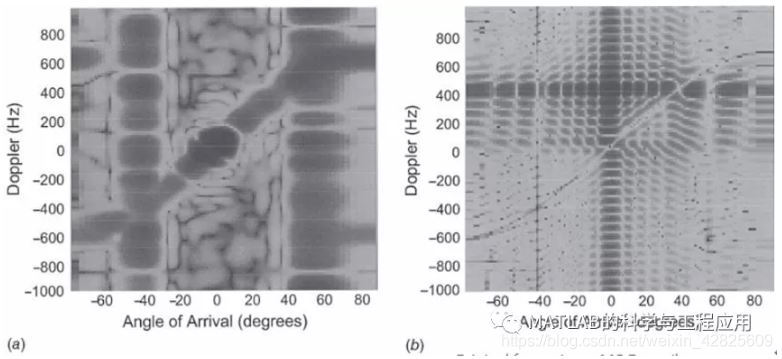【讀書2】【2014】基於MATLAB的雷達訊號處理基礎(第二版)——訊號調理與干擾抑制(1)
空時自適應濾波(STAP)結合角度和多普勒域的自適應波束形成,同時實現雜波和干擾的抑制。
Space-time adaptive filtering (STAP)combines adaptive beamforming in both angle and Doppler for simultaneoussuppression of clutter and jammer interference.
圖1.20說明了使用STAP進行干擾抑制的方法,從而允許檢測到以前不可檢測的目標訊號。
Figure 1.20 illustrates interferencesuppression using STAP, allowing a previously invisible target signal to beseen and perhaps detected.

Figure 1.20. 自適應波束形成效果的示例。(a)接收訊號功率作為到達角和訊號多普勒頻移的函式對映。(b)自適應處理後的角度-多普勒二維圖。Example of effect of adaptivebeamforming. (a) Map of received signal power as a function of angle of arrivaland signal Doppler shift. (b) Angle-Doppler map after adaptive processing.(Images courtesy of Dr. W. L. Melvin. Used with permission.)
圖1.20a中的兩條垂直條帶表示來自固定到達角的干擾能量,通常以相對寬頻的噪聲形式出現,因此干擾存在於雷達觀測到的所有多普勒頻率中。
The two vertical bands in Fig. 1.20a represent jammer energy, whichcomes from a fixed angle of arrival but is usually in the form of relativelywideband noise; thus it is present at all Doppler frequencies observed by theradar.
圖1.20a中的對角線條帶是由於地雜波引起的,因此多普勒頻移取決於從雷達到地面分塊的角度。
The diagonal band in Fig. 1.20a is due to ground clutter, for whichthe Doppler shift depends on the angle from the radar to the ground patchcontributing energy.
圖1.20b表明,自適應濾波已經沿著干擾和雜波能量的條帶區域產生零點,從而使得位於0°到達角和400Hz多普勒頻移的目標凸現出來。
Figure 1.20b shows that the adaptivefiltering has created nulls along the loci of the jammer and clutter energy,making the target at 0° angle of arrival and 400 Hz Doppler shift apparent.
自適應干擾抑制將在第九章中予以介紹。
Adaptive interference suppression will beintroduced in Chap. 9.
脈衝壓縮是匹配濾波的一種特殊情況。
Pulse compression is a special case ofmatched filtering.
許多雷達系統設計都力求在檢測目標時具有高靈敏度和良好的距離解析度(分辨相鄰距離很近的目標的能力)。
Many radar system designs strive for bothhigh sensitivity in detecting targets and fine range resolution (the ability todistinguish closely spaced targets).
接下來的章節表明,隨著發射能量的增加,目標可檢測效能提高,並且隨著發射波形的瞬時頻寬增加,距離解析度提高。
Upcoming chapters show that targetdetectability improves as the transmitted energy increases, and that rangeresolution improves as the transmitted waveform’s instantaneous bandwidthincreases.
如果雷達採用簡單的、恆定頻率的矩形包絡脈衝作為發射波形,則脈衝必須在時域加長以提高給定功率電平的發射能量。
If the radar employs a simple,constant-frequency rectangular envelope pulse as its transmitted waveform thepulse must be lengthened to increase the transmitted energy for a given powerlevel.
然而,脈衝寬度的增大也降低了其瞬時頻寬,從而降低了距離解析度。
However, lengthening the pulse alsodecreases its instantaneous bandwidth, degrading the range resolution.
因此,靈敏度和距離解析度之間似乎發生了相互衝突。
Thus sensitivity and range resolutionappear to be in conflict with one another.
通過將波形頻寬與其持續時間解耦,脈衝壓縮提供了一種擺脫這種困境的方法,從而避免了靈敏度和距離解析度之間的衝突。
Pulse compression provides a way out ofthis dilemma by decoupling the waveform bandwidth from its duration, thusallowing both to be independently specified.
這是通過放棄恆頻脈衝而設計調製波形來實現的。
This is done by abandoning theconstant-frequency pulse and instead designing a modulated waveform.
——本文譯自Mark A. Richards所著的《Fundamentals of Radar Signal Processing(Second edition)》
更多精彩文章請關注微訊號:
